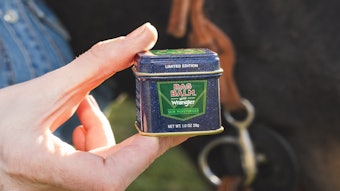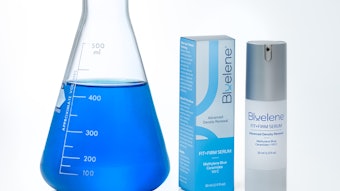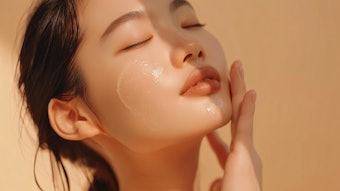- With consumers young and old seeking out anti-aging and preventative skin care, the market for innovative, effective products is bigger than ever.
- Industry suppliers are developing products through science and nature—and sometimes both—to create options for skin care that are novel, effective and marketable.
- Anti-aging is becoming relevant in hair care, leading more brands and industry suppliers to develop products and ingredients that address the ability for consumers to have more youthful hair as well.
It’s not your grandma’s wrinkle cream. One size fits all doesn’t work for today’s consumers anymore. “The anti-aging market is going to be much more specific moving forward,” explains Mibelle Biochemistry’s Beata Hurst. “We now need to treat the specific needs of consumers with precise applications.”
Hurst also notes, “The anti-aging market will continue to grow. But not like anything we’ve seen in the past as the market increasingly diversifies.” Thanks to baby boomers, aging consumers as a target market are growing faster compared to the general population, making the mature population more attractive for anti-aging companies. However, younger adults are not to be left behind, as they seek to address concerns early. “Advances in understanding the process of aging have helped cosmetic manufacturers realize that aging is not just a problem for people 45 and up,” says Anurag Pande PhD, vice president of scientific affairs, Sabinsa Corporation.
Science has allowed further understanding of the underlying causes of aging, which also has enabled anti-aging ingredients and formulations to specifically target various needs. No longer do products only assure a reduction in lines and wrinkles, but also aim to offer an improvement of skin structure, an even skin tone, diminution of pigmentation disorders, and increase elastin production for a firmer, more supple and healthier skin appearance. And new claims such as anti-glycation, anti-inflammation, anti-redness and growth factors will appear on consumer products and applications. But only those backed with science or a natural sourcing story and consumer-perceived results will stand out.
Futuristic Innovation
“Consumers want a more immediate effect from their cosmetic products,” says Caroline Magerl-Studer, founder of Mila D’Opiz, which will launch an all-in-one anti-aging night care product in April 2014. “Therefore, the cosmetic industry is developing diverse formulas that have an active influence on a cellular level to mimic more invasive procedures.”
Mibelle Biochemistry is focusing its anti-aging innovation on cell-to-cell communication, chronic inflammation and stem cells. “New findings in biochemistry and dermatology are the two main drivers for innovation,” says Hurst.
One of the results of aging is that the communication process between skin cells, which is mediated by growth factors that act as skin messenger molecules, is reduced. As a consequence, the activity of fibroblasts decreases. Unfortunately, this strongly affects the extracellular matrix, the structural network of the skin. The result is a reduction in the skin’s firmness, elasticity and density. Because it’s a hormone, growth factors within products are not allowed in the U.S. or Europe. However, it is helpful to have ingredients that activate the skin’s own growth factors within the dermis and epidermis, Hurst explains. Mibelle’s DermCom ingredient both improves and repairs skin texture through its growth factor-like activity.
Stem cells also continue to be popular as they work to repair damaged skin quickly. One example is Evonik’s Tego Stemlastin, which helps protect and maintain epidermal stem cell capacity and boost the elastic fiber network. Based on a standardized extract of the micro algae Cyanidium caldarium, which is able to survive under extreme environmental conditions, the extract delivers a special intracellular composition of extremolytes like mineral nutrients, amino acids and algae polyphenols—and is enriched in gamma amino butyric acid. In vitro studies have shown Tego Stemlastin protects and maintains epidermal stem cell capacity for rejuvenated skin activity while also boosting elastic fibers, leading to supple skin and reduction of skin elasticity fatigue. Thus, Stemlastin leads to improved skin elasticity and diminishes wrinkles, especially crow’s feet, through its activity on epidermal stem cells and elastic fibers.
Mature women also are concerned about skin problems during menopause, which are closely linked with hormonal changes. “They are looking for an effective product that makes them feel comfortable during the time in their life when everything turns upside down,” says Manuela Pflaumbaum, global marketing manager, actives, Evonik. Evonik’s Tego Arjuna S is a standardized plant extract of penta cyclic triterpenes with improved bioavailability. It combats the signs and effects of hormonal aging on postmenopausal skin without influencing hormonal activity, for example.
Innovating Performance
Denise Gabriele, vice president, sales and marketing, Sederma, says true innovation is “performance based on a new molecule—natural or synthetic—that targets and addresses a new mechanism, or addresses a new consumer benefit.” An example would be Sederma’s Beautifeye, which demonstrates lifting of a droopy upper eyelid. [Beautifeye won the Cosmetics & Toiletries R&D Award—Asia for Best New Ingredient Award at in-cosmetics Asia, Oct. 30, 2013. The award is presented by GCI sister publication Cosmetics & Toiletries.]
“Based on a dual-action approach, Beautifeye treats the global contour of the eye by lifting the fold of the eyelid at the top and lessening the crow’s feet wrinkles on the sides by strengthening the dermal structure and increasing its contractile properties,” says Gabriele. It also helps to fade dark circles and diminish puffiness by consolidating the microvascular network and reducing pigmentation. And while clinical studies have demonstrated the positive effects, what’s more important is that the consumer sees the difference. “If the consumer does not perceive a benefit, she won’t purchase [the product] again,” Gabriele explains.
In order to correct the damage, it’s important to understand the underlying causes of visible skin aging. Senescence—also known as the process of deterioration with age—changes the functionality of cells responsible for building the skin matrix. “Prior to senescence, these cells produce key structural proteins such as collagen and elastin and other skin-protective molecules that maintain skin’s vitality and firmness,” explains Sonia Dawson, marketing manager, botanicals, Croda Inc. “However, after senescence, these cells switch activity and produce high amounts of destructive molecules that accelerate visible skin aging by breaking down various components of the skin.” The accumulation of these cells with age has visible effects such as thin and sagging skin and an abundance of pigmented age spots. Recent studies show certain small, signal-blocking molecules known as microRNAs are directly involved in the occurrence of senescence.
Sederma, therefore, developed Senestem, a high-tech active proven to fade signs of senescence with an approach targeting microRNAs. “We’re targeting aging at the source,” says Dawson, and this micro approach leads to a visible macro effect: skin recovers its density, firmness and elasticity, and age spots lightened.
It’s also a natural solution, created using Sederma’s HTN (High Tech Nature) Plant Cell Amplification method, developed by the scientists at Sederma’s Instituto di Ricerche Biotecnologiche (IRB). “This proprietary process is an eco-friendly and highly sustainable means for the precise selection and amplification of the most desired natural molecules, reaching levels 1,000 times greater than those achieved from traditional means,” explains Dawson. “It is due to the high levels of specific plant molecules uniquely suited for this cosmetic activity that we are able to deliver such visible benefits.”
Eco-consciousness
As if biotechnology and cell manipulation weren’t enough, consumers are drawn to natural beauty products for the skin, in addition to the environment around them. “What we put onto our bodies is as important as what we put into them,” says Karen King, co-founder of La Bella Figura, which selects ingredients based on their effectiveness as well as their sustainability.
Natural ingredients and methodologies are increasing in all segments of the beauty market. Lisa Carroll, co-founder of Native Extracts of Australia, comments, “Consumers want their products to be as close to the natural source—in its natural environment—as possible. That means increased pressure for raw material manufacturers to provide independent scientific proof of what they say their products do, which is a great thing for this industry, formulators, product development and consumers.” As technologies emerge, it will open up new possibilities to develop products that can deliver advanced results.
“We have created a new extraction technology that creates superior water-soluble extracts compared to traditional methods,” says Carroll. Native Extracts’ new cellular technology delivers potent levels of active compounds from nature, allowing product developers to do away with synthetic options. The cellular extraction method captures an abundance of bio-actives, delivering a rapid, clean, fresh extract without heat or degradation of the raw material or altering the plant profile.
Native Extracts also was able to stabilize vitamin C for an extended period—more than 12 months—in an aqueous matrix featuring the kakadu plum extract. “The future lies in new discoveries from rare sources and new technologies to release bio-active compounds from within nature’s cells—the building blocks of life—and credible scientific verification of their activity,” says Carroll.
Sabinsa will soon launch a peptide-based product in the market, which will be innovative in its composition as well as function. “It is functionally very unique and effective in very small concentrations as compared to the crude or semi-crude plant extracts,” explains Pande.
The production of this peptide is different from the usual extraction and isolation of plant-based compounds. “Olepent is not a usual peptide product, but actually is a novel amalgamation of phytochemistry and peptide science,” Pande says. Olepent will address various skin aging concerns such as wrinkles, collagen break down, scarring and age spots. It is unique as it functions on two levels, acting as both a repairing and firming peptide. The peptide’s anti-inflammatory activity will help in minimizing the effects of enzymes such as collagenase and elastase, which can break down the skin matrix, and it will help repair skin barrier dysfunction. Being able to combine a natural sourcing story with innovative technology is an ideal way to pique consumer interest.
Inflamm-aging
While extrinsic factors such as UV exposure, chemicals and pollution play a major role in the aging process, inflammation is now recognized as a major cause of intrinsic aging too. With age, the immune system becomes less effective and inflammatory activity increases. This can lead to chronic inflammation characterized by a slow but continuous production of free radicals, causing wrinkles and sagging skin. “Inflammation is a vicious cycle that leads to wrinkles and other signs of aging,” says Hurst.
Mibelle is looking to inhibit inflammatory reactions with MAXnolia, a water-dispersible active powder based on magnolia bark extract, a natural inhibitor of the pro-inflammatory transcription factor NF-KB. Mibelle also is looking to introduce CM-Naringenin-Chalcone, a single molecule derived from naringenin, a flavanone naturally occurring in the peel of citrus fruit. In a clinical study performed on volunteers with rosacea skin, CM-Naringenin-Chalcone clearly diminishes capillary blood flow and therefore the appearance of facial redness.
Glycation, the binding of a protein molecule to a glucose molecule, causes many aging symptoms as well. Proteins such as collagen and elastin can get damaged by reducing sugars under harsh conditions. This leads to the formation of advanced glycation end (AGE) products, which then react with cellular receptors to produce inflammatory reactions. The accumulation of AGEs leads to a gradual stiffening and loss of firmness and elasticity of the skin. Anti-glycation and anti-aging compounds, such as theraglycan-3, act to reduce actual AGE content in the skin and will be an emerging trend moving forward.
Preventative Care
Younger consumers are looking for moisturizing benefits and sun protection in addition to wrinkle prevention and lightening dark spots. Formulated with a brightening complex and featuring vitamin C to reduce discoloration, First Aid Beauty’s Facial Radiance Serum is aimed at all ages.
“With the prevalence of sun damage and challenges like acne discoloration and uneven skin tone, there is a huge demand for products that address these concerns,” says First Aid Beauty founder Lilli Gordon.
Merck introduced an active ingredient that prevents skin tanning and decreases hyperpigmentation. RonaCare Pristine Bright inhibits tyrosinase, an enzyme that plays an important role in the formation of melanin. At the same time, Merck launched RonaCare Bronzyl to inhibit skin aging caused by exposure to UV radiation. The ingredient stimulates the production of melanin and activates the natural tanning process, inducing the skin to build up its own natural UV protection. “The market segment for cosmetic active ingredients that use a biological mode of action to allow the body to tan is still very new,” says Michael Weiden, Merck’s head of functional materials within its pigments and cosmetics business unit. “We are convinced that this technologically sophisticated segment will see strong growth in the coming years, and we look forward to helping to shape it.”
Both UV and infrared (IR) induce skin damage but in different ways, and therefore, IR protection requires specialized strategies. Sederma finished new tests for Venuceane, an anti-aging active offering UV protection demonstrated to be highly efficient against IR aging. “Infrared represents more than 50% of solar radiation, and is a major contributor of photoaging and even photo-carcinogenicity,” says Gabriele. Derived by biotechnology, Venuceane is a ferment that is rich in multifunctional and stable enzymes. It helps improve hydration via the protection of the mitochondrial integrity known to be particularly damaged by IR radiation, lessens the inflammatory conditions, and protects collagen integrity and elastin architecture in order to limit wrinkle formation.
Hair Rising
The latest trend in hair care has been influenced by the anti-aging standard in skin care. Age and exposure to chemicals depletes the protein and lipid content of hair, damaging the surface and accelerating the aging process. Keratin is a natural supplement choice that provides rejuvenation and an overall healthy appearance; however, natural keratin does not readily adhere to hair and must be chemically processed. Salvona’s HydroSal SalSilk is designed to address the need for a healthy keratin treatment that yields results without the use of formaldehyde. HydroSal SalSilk is a water-based, sub-micron sphere delivery system. The driving innovation of the product is the supplier’s HydroSal platform, a translucent suspension of sub-micron spheres. “The release of encapsulated ingredients from the porous core of HydroSal is controlled by diffusion and triggered by contact with moisture,” shares Shai Shefer, CFO and CIO, Salvona.
The goal is to take proven ingredients and enhance their capabilities using encapsulation methods. “Kind of like transforming Clark Kent into Superman,” Shefer says. Anti-aging hair products have huge potential. “By giving that boost to existing ingredients, or combining several functional ingredients in an encapsulation that creates synergistic benefits, we make it safer and more approachable to consumers and provide an encapsulation system that allows the formulator to easily include a variety of valuable, hair-enriching ingredients in one thoughtful product,” Shefer explains.
Looking Ahead
In the current market, which has been flooded with products, only proper science and innovation can help a product succeed. “As technology evolves, we learn more about the key contributors of aging, how to influence them and how to evaluate the end consumer benefits,” says Gabriele.
Moving forward, research-based companies will be innovating products, and new delivery systems will be used to improve the efficacy of current products for specific needs. “The science behind the products will be most important for sustaining the interest of consumers as they seek results,” says Pande. “Allowing the product to speak for itself.”
Sara Mason is a freelance writer based in the Chicagoland area. She was previously managing editor of GCI magazine.










